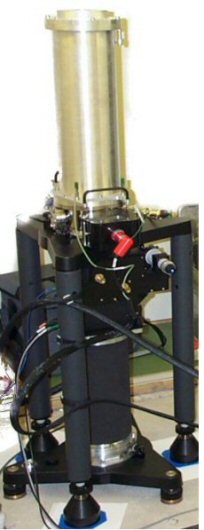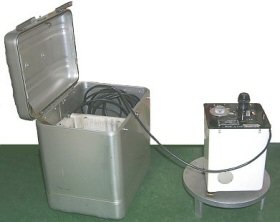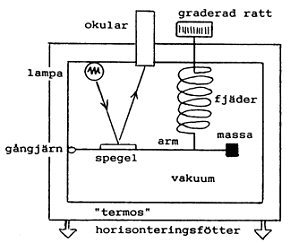Contents of this page may be automatically translated, we take no responsibility for the accuracy of the translation. Feel free to contact our customer support centre if you have any questions.

There are two principles for gravity measurement - absolute or relative measurement.
Two types of gravimeters
Gravity (= g) is measured with a gravimeter. There are two completely different types of gravimeters:
- Gravimeters for absolute gravity measurement, which are available in very limited numbers; six in the Nordic countries.
- Gravimeters for relative gravity measurement, of which there are about ten in Sweden.
 The image on the left shows an absolute gravimeter, of the type FG5, which is used to perform absolute gravity measurements with the highest possible accuracy. Since 2006, Lantmäteriet is the owner of one and it is used partly to calculate land uplift, partly to provide good fundamental points for gravity networks and systems.
The image on the left shows an absolute gravimeter, of the type FG5, which is used to perform absolute gravity measurements with the highest possible accuracy. Since 2006, Lantmäteriet is the owner of one and it is used partly to calculate land uplift, partly to provide good fundamental points for gravity networks and systems.
Absolute gravity measurement
Absolute gravity measurement means direct determination of gravity on a certain point.It generally involves measuring the acceleration of a free-falling prism in vacuum. This is a complicated procedure and advanced instruments are required. Thus, this type of gravity measurement is performed in a limited number of places in the world.In Sweden we currently have more than ten stations for absolute gravity measurement. The picture on the left shows the measurement of absolute gravity in Mårtsbo, where Sweden's first fundamental point for gravity is located.
Relative gravity measurement
From, for example, Mårtsbo, it is possible with the simpler method, relative gravity determination, to determine g at other points. You then use a completely different type of gravimeter where you use, for example, a coil spring to measure differences in gravity between different points.
 When measuring with a relative gravimeter you do not directly get a value for the gravity acceleration, g. However, you get the difference between the gravity acceleration for the places you measure. If you start on a point with known g-value, you can thus calculate the g-value of all the following points you measure. Currently, there are two dominant brands for relative gravimeters, namely LaCoste & Romberg and Scintrex. The former is shown in the image to the right.
When measuring with a relative gravimeter you do not directly get a value for the gravity acceleration, g. However, you get the difference between the gravity acceleration for the places you measure. If you start on a point with known g-value, you can thus calculate the g-value of all the following points you measure. Currently, there are two dominant brands for relative gravimeters, namely LaCoste & Romberg and Scintrex. The former is shown in the image to the right.
Absolute gravimeters, unlike relative gravimeters, are very large and ungainly, but like the relative gravimeter need a continuous supply of power and are also extremely sensitive to harsh treatment.

The principle of relative measurement
As gravity increases, the mass is pulled downwards, whereby the arm tilts and the light beam ends up obliquely in the eyepiece. By screwing on the steering wheel, you tighten the spring, so that the mass is pulled upwards and the light beam again hits the center of the eyepiece. Then you can finally read on the steering wheel how many parts of the shell it has been rotated. On later instruments the operation is much easier and you also get help with the leveling by the display showing how to turn the three instrument feet. But even if you get a lot of help from the instrument, it is still important to be really careful in what you do.

